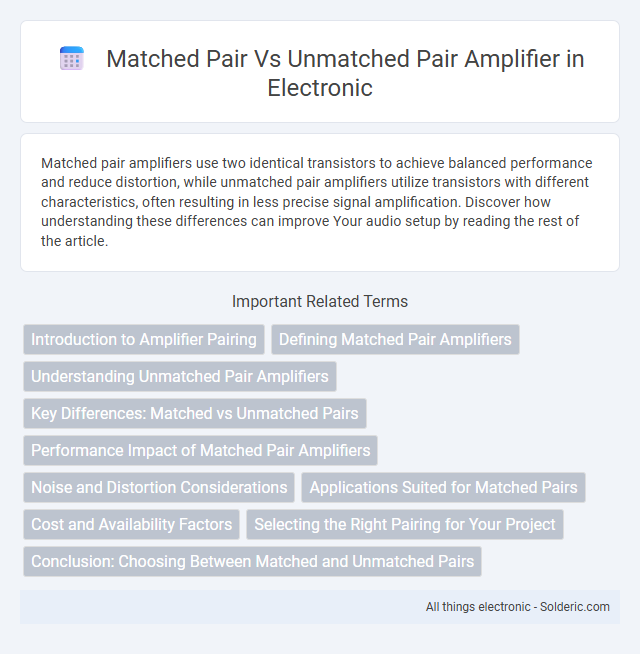Matched pair amplifiers use two identical transistors to achieve balanced performance and reduce distortion, while unmatched pair amplifiers utilize transistors with different characteristics, often resulting in less precise signal amplification. Discover how understanding these differences can improve Your audio setup by reading the rest of the article.
Comparison Table
| Feature | Matched Pair Amplifier | Unmatched Pair Amplifier |
|---|---|---|
| Transistor Matching | Uses transistors with closely matched electrical characteristics | Uses transistors without matching, with varying parameters |
| Common Application | Differential amplifiers, precision analog circuits | General-purpose amplifiers, non-critical applications |
| Input Offset Voltage | Low input offset voltage due to matching | Higher input offset voltage |
| Thermal Stability | Better thermal drift performance | Less thermal stability |
| Gain | Higher gain accuracy | Less gain precision |
| Noise Performance | Lower noise due to matched devices | Higher noise levels |
| Cost | Higher cost due to selection and matching | Lower cost, no selection required |
Introduction to Amplifier Pairing
Matched pair amplifiers consist of two transistors or tubes selected for nearly identical electrical characteristics, ensuring balanced gain, noise performance, and distortion levels. Unmatched pair amplifiers use components without this precise selection, which can result in uneven signal amplification and increased distortion. Your audio system benefits from matched pairs by achieving better sound fidelity and stability.
Defining Matched Pair Amplifiers
Matched pair amplifiers use two transistors or components with closely matched electrical characteristics, ensuring consistent gain and reduced distortion. These pairs are selected based on parameters like current gain (hFE) and threshold voltage to achieve optimal symmetry and stability in audio or signal amplification. Your circuit's performance benefits significantly from the precision and reliability provided by matched pair amplifier configurations compared to unmatched pairs.
Understanding Unmatched Pair Amplifiers
Unmatched pair amplifiers consist of transistors or components with differing electrical characteristics, resulting in variations in gain and performance. Understanding unmatched pair amplifiers is crucial because they can introduce distortion and reduce overall signal fidelity compared to matched pair configurations. Your circuit design must account for these inconsistencies to achieve optimal amplification and minimize noise.
Key Differences: Matched vs Unmatched Pairs
Matched pair transistors exhibit nearly identical electrical characteristics such as gain, current, and voltage parameters, resulting in improved amplifier linearity, reduced distortion, and better noise performance. Unmatched pair transistors have varying parameters, leading to increased offset voltages, higher distortion, and potentially less stable operating points within the amplifier circuit. Choosing matched pairs is critical in differential amplifiers and precision instrumentation where balance and symmetry directly enhance signal integrity and overall performance.
Performance Impact of Matched Pair Amplifiers
Matched pair amplifiers offer significantly enhanced performance by minimizing distortion and noise through closely matched transistor characteristics, resulting in better linearity and improved signal fidelity. Unmatched pair amplifiers typically exhibit higher offset voltages and increased harmonic distortion due to variations in transistor parameters. The use of matched pairs ensures superior common-mode rejection ratio (CMRR) and thermal stability, critical for precision amplification applications.
Noise and Distortion Considerations
Matched pair amplifiers typically offer lower noise levels and reduced distortion due to the closely matched transistor parameters, ensuring balanced signal amplification and consistent performance. Unmatched pair amplifiers may introduce higher noise and distortion because discrepancies in transistor characteristics can cause imbalances, leading to signal degradation. Choosing a matched pair amplifier enhances Your audio system's clarity and fidelity by minimizing unwanted noise and harmonic distortion.
Applications Suited for Matched Pairs
Matched pair amplifiers are ideal for applications requiring precise signal integrity and minimal distortion, such as audio amplification in high-fidelity sound systems and sensitive instrumentation. They excel in differential amplifier circuits used in operational amplifiers and analog signal processing where balanced transistor characteristics enhance performance. Unmatched pair amplifiers may be suitable for simpler, cost-sensitive designs where exact matching is less critical, but matched pairs ensure superior linearity in precision audio, measurement, and communication equipment.
Cost and Availability Factors
Matched pair amplifiers often come at a higher cost due to the rigorous testing and selection process required to ensure transistor pairs have nearly identical electrical characteristics. Unmatched pair amplifiers are generally more affordable and widely available since they use standard transistors without precise matching, making replacement and sourcing easier. When considering your budget and component accessibility, unmatched pairs provide a practical solution without the expense or delay associated with matched components.
Selecting the Right Pairing for Your Project
Matched pair amplifiers use transistors or tubes with nearly identical electrical characteristics, ensuring consistent performance and reduced distortion, ideal for high-fidelity audio projects. Unmatched pair amplifiers, while less precise, offer flexibility and cost savings for applications where exact matching is less critical. Choosing the right pairing depends on your project's performance demands and budget constraints.
Conclusion: Choosing Between Matched and Unmatched Pairs
Choosing between matched and unmatched pair amplifiers depends on the desired audio fidelity and application environment. Matched pair amplifiers provide balanced performance with reduced distortion and noise, ideal for high-precision audio setups and professional use. Unmatched pair amplifiers offer greater flexibility and cost efficiency but may introduce slight variations in sound quality, making them suitable for general consumer electronics where perfect balance is less critical.
matched pair vs unmatched pair amplifier Infographic

 solderic.com
solderic.com